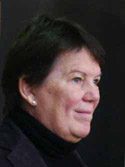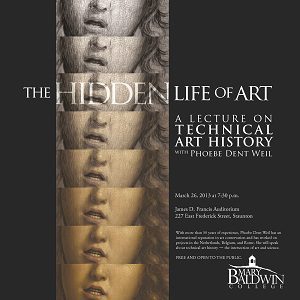For more than 50 years, Phoebe Dent Weil has been at the forefront of technical art history — the scientific and aesthetic study of how a work of art was made and how it has changed over time. Weil will speak about her extensive work in art history and conservation next week at Mary Baldwin University.
“In the course of my conservation career, I have discovered that conservators have a privileged relationship to art; we can see and touch it and sometimes transform it, in a good way, to what it was originally like,” Weil said.
Scientific  advances in examining art have enabled conservators to study how an artist worked on a particular painting. Under high magnification, a painting’s under-drawings, structure, and layers come into view. Conservators are then able to see how the artist changed his mind while working, how he did something other than what he originally planned, Weil explained.
advances in examining art have enabled conservators to study how an artist worked on a particular painting. Under high magnification, a painting’s under-drawings, structure, and layers come into view. Conservators are then able to see how the artist changed his mind while working, how he did something other than what he originally planned, Weil explained.
“Technical art history, which is a fairly new field, is the most wonderful way to teach and relate people to art in ways that were previously not possible without current scientific techniques,” she said.
An important part of Weil’s approach is studying materials and, through that study, fostering viewers’ ability to appreciate art. In a class she teaches at Smith College in Massachusetts, students make paint and handle materials to emulate old master’s techniques, so that they understand by doing.
“You see with new eyes if you have an understanding of the materials,” Weil said.
At Mary Baldwin, Lundy Pentz, associate professor of biology, and Sara Nair James, professor of art history, are teaching an honors colloquium this semester on technical art history, based on the seminar they attended in summer 2011 at New York University’s Institute of Fine Arts. Weil was a presenter at the 2011 seminar, and she will be a guest teacher at Pentz and James’s class next Wednesday.
“Phoebe is coming because courses such as ours are so new and so rare,” James said.
Weil specialized in the technical examination and treatment of large-scale outdoor bronze sculptures. She worked on “Statue of Freedom” atop the United States Capitol, statues on Monument Avenue in Richmond, and sculptures in New York City’s Central Park. She and her colleagues developed new ways to tre at outdoor statues — the type of art that the public most often sees — to prevent deterioration and restore beauty.
at outdoor statues — the type of art that the public most often sees — to prevent deterioration and restore beauty.
Weil is internationally renowned in her field and has worked on projects in the Netherlands, Belgium, and Italy, among other countries. She is co-director of the Northern Light Studio, where she teaches classes in historic painting and drawing techniques and promotes education in technical art history. She was awarded the James Marston Fitch Residency at the American Academy in Rome in 2007 and returned to the academy as a visiting scholar in 2008. In 1973, she became director of the Sculpture Conservation Laboratory of the Center for Archaeometry at Washington University in St. Louis. She received a bachelor of arts from Wellesley College and a master of arts in art history from the Institute of Fine Arts at New York University. In addition to her work in art conservation, she is also an ordained Episcopal priest.
Weil’s lecture, “The Hidden Life of Art,” will begin at 7:30 p.m. on March 26 in the James D. Francis Auditorium on the third floor of Pearce Science Center at Mary Baldwin. It is free and open to the public. For more information, please call 540-887-7009.